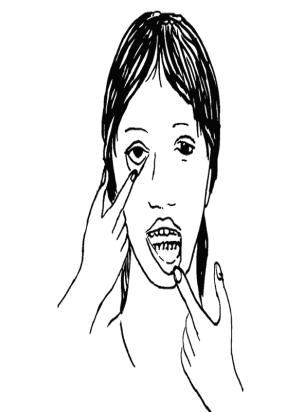Checking for signs of anemia
When someone has anemia, it usually means the person has not been able to eat enough food containing iron or he/she must be ill. Iron helps the red blood cells to carry oxygen inhaled to all parts of the body. But in other situations, anaemia are inherited (genetic) and cannot be cured by eating iron-rich foods or taking iron pills.




Warning Signs and Symptoms for Development of Anemia
- Paleness (pale conjunctiva, fingernails, gums and tongue). (see figure 8.2 above)
- Dizziness or fainting.
- Weakness or tiredness.
- Fast pulse (over 100 beats per minute).
- Difficulty breathing (shortness of breath).
Assessment of Maternal Vital Signs
Checking temperature
Body temperature is measured using an instrument called thermometer, which has a "bulb" at one end, usually filled with a silver liquid metal called mercury (see figure 8.3A). (Some glass thermometers contain a red dye instead and some use digital technology (see figure 8.3B). In a glass thermometer, when the bulb of mercury is warmed by body temperature, the mercury expands and rises the thin glass tube, which is marked with numbers showing the patient's body temperature.

Normal temperature
Normal temperature is close to 37°C, or 98°F. The woman does not feel hot n touching.
How to Check Temperature
If you don't have a thermometer, put the back of one hand on the woman's forehead, and the other on your own, or that of another healthy person. If the woman has a fever, you should be able to feel that her skin is hotter than that of a healthy person.
If you have a glass thermometer, clean it well with soap and clean water, or alcohol. Hold the thermometer with the "bulb" containing the silver mercury pointing away from your hand. Shake it with a snap of the wrist, until the top of the thin column of silver mercury falls well below "normal" body temperature, i.e. less than 36°C (or 96°F).Put the bulb end of the thermometer under the woman's tongue or in her armpit, and leave it there for three minutes. The woman should keep her mouth closed, or her arm close to her body.Take the thermometer out and turn it until you see the silver line. The point where the silver stops marks the temperature. There is usually a little arrow at the "normal" point.
Always clean the thermometer with soap and fresh water, or with alcohol, after you use it. Do not use hot water; it can break the thermometer! Mercury is a very poisonous metal. Be careful with glass thermometers, and if they break, do not pick up the mercury with your bare hands. Sweep the mercury into a jar and bury it. Do not let children play with thermometers or mercury. Get a digital thermometer if you can.
What to Do if the Woman has Fever
Fever can be caused by:
- Sickness like flu or malaria.
- An infection of part of the body such as bladder infection, or infection of the uterus.
- Dehydration (loss of body fluids due to not drinking enough water). It is a mild fever.
A high fever needs to be lowered right away. To reduce the fever, do the following:
- Give 500 to 1,000 mg (milligrammes) of paracetamol by mouth every four to six hours.
- Have her drink one cup of fluid every hour.
- Wipe her body with a cloth dipped in cool water.
- If the fever does not come down in 8 hours, refer her to a health centre.